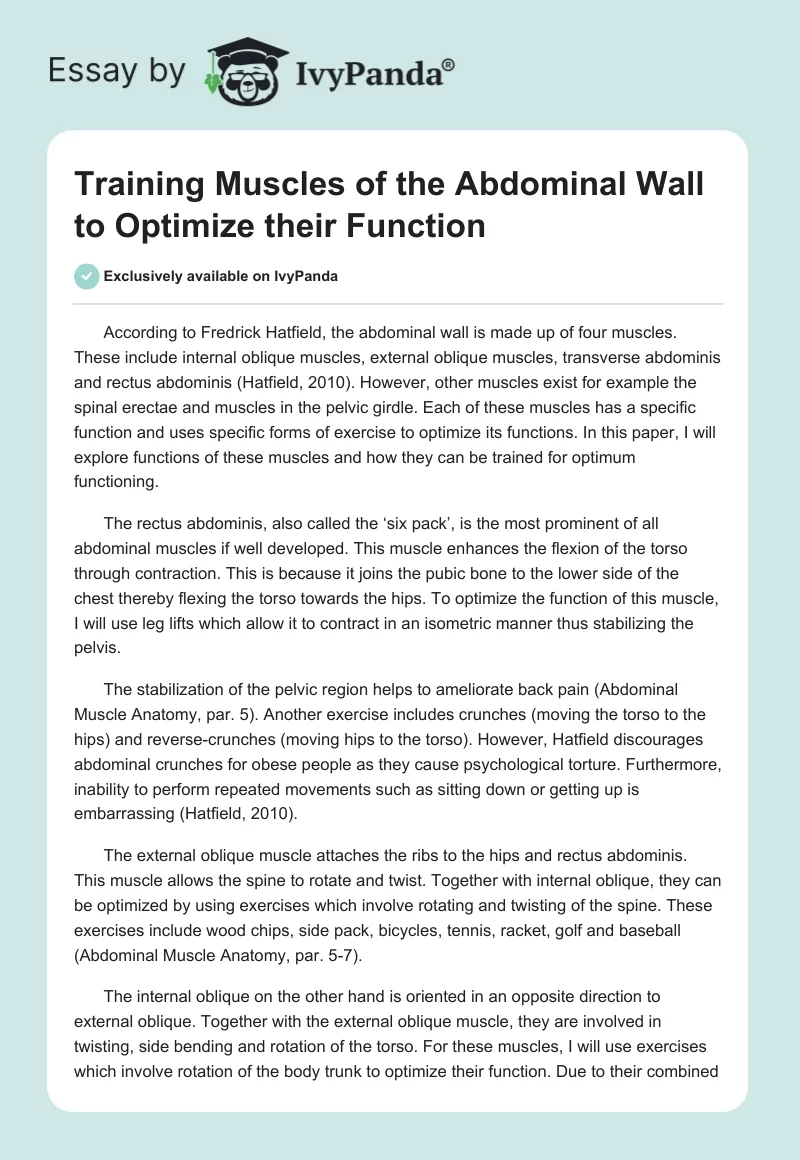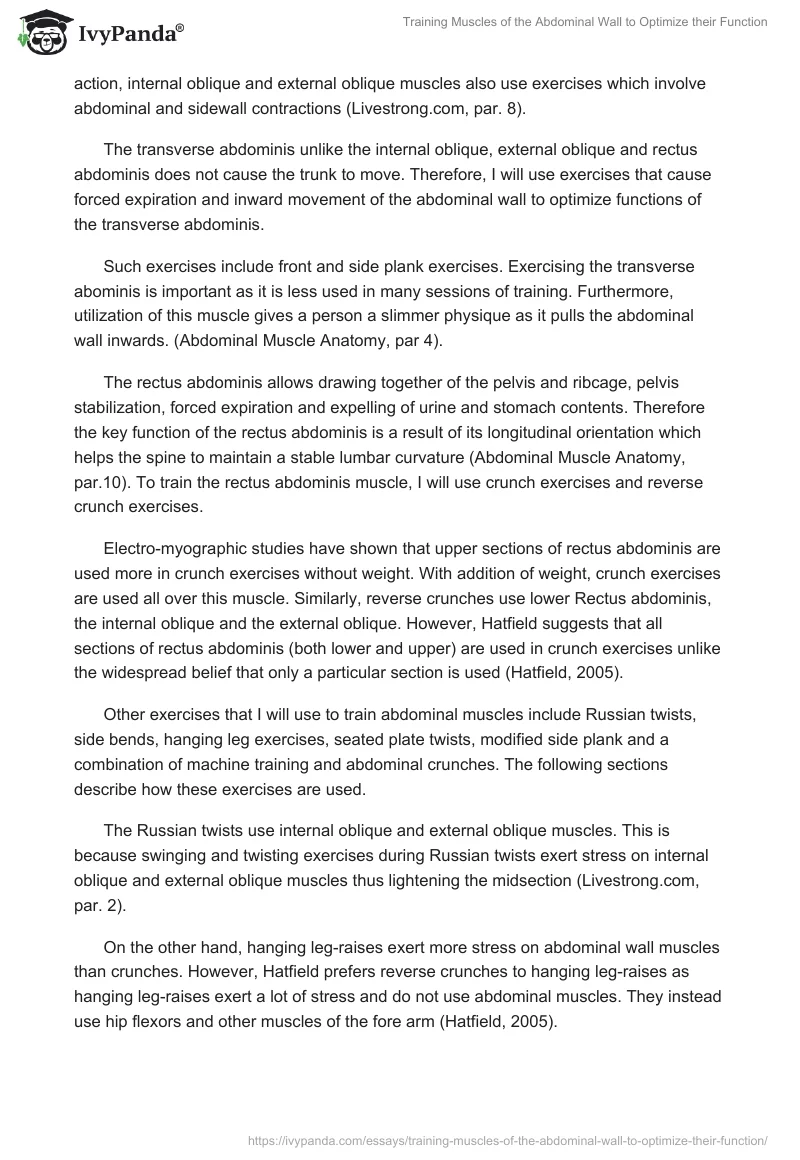According to Fredrick Hatfield, the abdominal wall is made up of four muscles. These include internal oblique muscles, external oblique muscles, transverse abdominis and rectus abdominis (Hatfield, 2010). However, other muscles exist for example the spinal erectae and muscles in the pelvic girdle. Each of these muscles has a specific function and uses specific forms of exercise to optimize its functions. In this paper, I will explore functions of these muscles and how they can be trained for optimum functioning.
The rectus abdominis, also called the ‘six pack’, is the most prominent of all abdominal muscles if well developed. This muscle enhances the flexion of the torso through contraction. This is because it joins the pubic bone to the lower side of the chest thereby flexing the torso towards the hips. To optimize the function of this muscle, I will use leg lifts which allow it to contract in an isometric manner thus stabilizing the pelvis.
The stabilization of the pelvic region helps to ameliorate back pain (Abdominal Muscle Anatomy, par. 5). Another exercise includes crunches (moving the torso to the hips) and reverse-crunches (moving hips to the torso). However, Hatfield discourages abdominal crunches for obese people as they cause psychological torture. Furthermore, inability to perform repeated movements such as sitting down or getting up is embarrassing (Hatfield, 2010).
The external oblique muscle attaches the ribs to the hips and rectus abdominis. This muscle allows the spine to rotate and twist. Together with internal oblique, they can be optimized by using exercises which involve rotating and twisting of the spine. These exercises include wood chips, side pack, bicycles, tennis, racket, golf and baseball (Abdominal Muscle Anatomy, par. 5-7).
The internal oblique on the other hand is oriented in an opposite direction to external oblique. Together with the external oblique muscle, they are involved in twisting, side bending and rotation of the torso. For these muscles, I will use exercises which involve rotation of the body trunk to optimize their function. Due to their combined action, internal oblique and external oblique muscles also use exercises which involve abdominal and sidewall contractions (Livestrong.com, par. 8).
The transverse abdominis unlike the internal oblique, external oblique and rectus abdominis does not cause the trunk to move. Therefore, I will use exercises that cause forced expiration and inward movement of the abdominal wall to optimize functions of the transverse abdominis.
Such exercises include front and side plank exercises. Exercising the transverse abominis is important as it is less used in many sessions of training. Furthermore, utilization of this muscle gives a person a slimmer physique as it pulls the abdominal wall inwards. (Abdominal Muscle Anatomy, par 4).
The rectus abdominis allows drawing together of the pelvis and ribcage, pelvis stabilization, forced expiration and expelling of urine and stomach contents. Therefore the key function of the rectus abdominis is a result of its longitudinal orientation which helps the spine to maintain a stable lumbar curvature (Abdominal Muscle Anatomy, par.10). To train the rectus abdominis muscle, I will use crunch exercises and reverse crunch exercises.
Electro-myographic studies have shown that upper sections of rectus abdominis are used more in crunch exercises without weight. With addition of weight, crunch exercises are used all over this muscle. Similarly, reverse crunches use lower Rectus abdominis, the internal oblique and the external oblique. However, Hatfield suggests that all sections of rectus abdominis (both lower and upper) are used in crunch exercises unlike the widespread belief that only a particular section is used (Hatfield, 2005).
Other exercises that I will use to train abdominal muscles include Russian twists, side bends, hanging leg exercises, seated plate twists, modified side plank and a combination of machine training and abdominal crunches. The following sections describe how these exercises are used.
The Russian twists use internal oblique and external oblique muscles. This is because swinging and twisting exercises during Russian twists exert stress on internal oblique and external oblique muscles thus lightening the midsection (Livestrong.com, par. 2).
On the other hand, hanging leg-raises exert more stress on abdominal wall muscles than crunches. However, Hatfield prefers reverse crunches to hanging leg-raises as hanging leg-raises exert a lot of stress and do not use abdominal muscles. They instead use hip flexors and other muscles of the fore arm (Hatfield, 2005).
Side bends, like crunch exercises, help in stabilizing the back. This is because it uses internal and external oblique including other muscles like quadratus lumborum. When using the side bends, the client bends sideways while holding a dumbbell (Hatfield, 2005). The external oblique and internal oblique muscles are pre-stretched by the arm which is behind the head. This optimizes function of internal and external oblique muscles (Body and Fitness, par. 6-7).
A combination of machine training and abdominal crunch is a full range approach that I will use to train abdominal muscles. Hatfield refers to curved back peddling as the best example of this combination. This is because it uses an overhead pulley that stabilizes the back thus reducing back pain and giving a full range approach to training (Livestrong.com, par. 3-8).
In addition, when using seated plate twists, I will instruct the client to perform side to side rotations while touching the plate on the floor in a sitting position with the legs stretched out. Seated plate twists exert stress on internal oblique and external oblique muscles thus optimizing their function (Body and Fitness, par. 3-6).
Knowledge of various abdominal muscles and how they can be used in training is very critical in training my clients, friends and family. Applying abdominal exercises in abdominal muscle training is an important lesson which I will use to reduce instances of back pain in my clients.
This is because a healthy abdominal wall helps to stabilize the back thus reducing back pain (Hatfield, 2010). Furthermore, I will use exercises such as front plank and side plank exercises to train the transverse abdominis muscle thus giving my clients the slim profile they desire.
This is unlike the dietary approach I had initially used for my clients to enhance weight loss. In training my clients, friends and family, I will apply the knowledge gained that the upper and lower sections of the abdomen (rectus abdominis) are not necessarily isolated by exercises like crunches and reverse crunches. This is because all exercises produce stress equally through an abdominal muscle and there is no upper or lower section that is isolated (Hatfield, 2005).
During my training exercises, I will not apply hanging leg exercises for abdominal muscle training as they do not develop abdominal wall muscles but instead develop hip flexor muscles.
Since Hatfield suggests that “there are many abdominal exercises, and there are just as many abdominal exercise-devices”, it is necessary that I make the appropriate choices during training to meet the needs of my family, clients and friends (Hatfield, 2010). This is because an informed choice on forms of exercises to use will result in optimum muscle function thereby providing a healthy spine for exercise.
References
Abdominal Muscle Anatomy. Web.
Body and Fitness: Inspiring beyond sports. Web.
Hatfield, F.C. (2005). Fitness: The complete guide to dumbbell training. Santa Barbara, CA: International Sports and Sciences Association.
Hatfield, F. C. (2010). Fitness: The complete guide. Santa Barbara, CA: International Sports and Sciences Association.
Livestrong. Oblique abdominal muscle exercises. Web.


